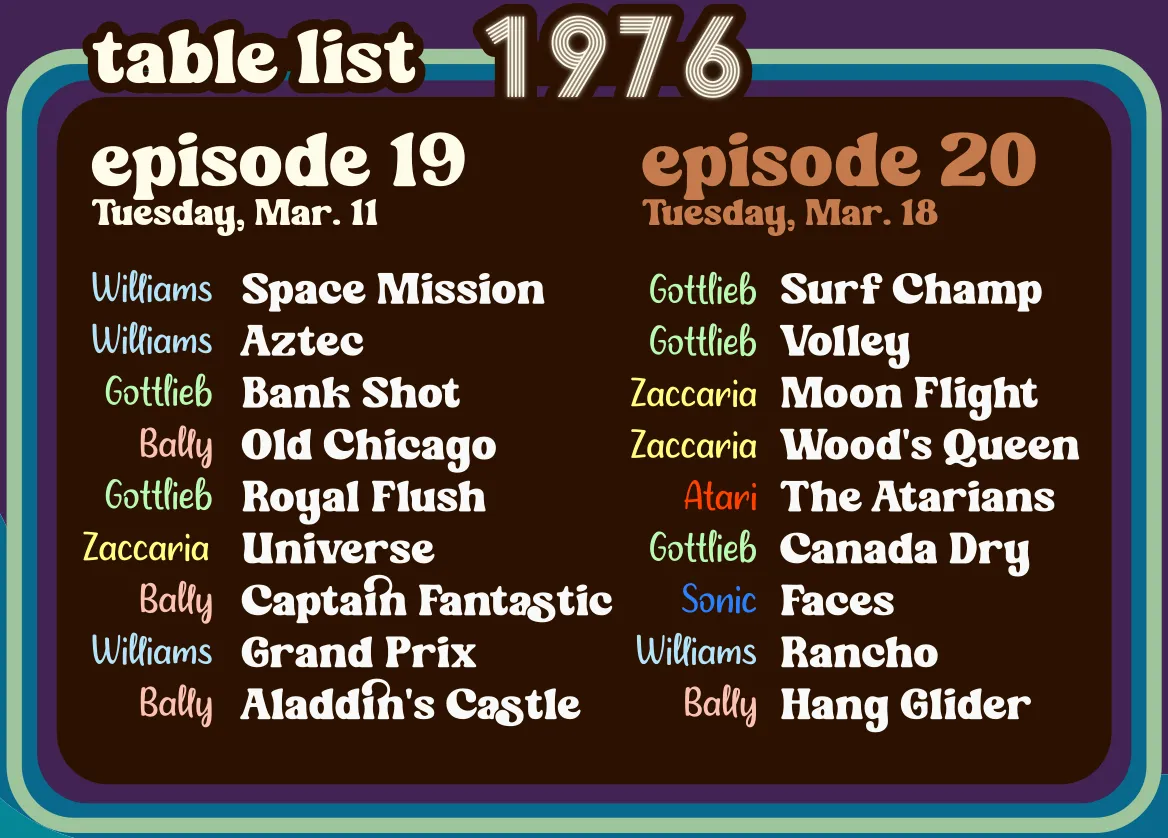Silver Ball Century ep. 19 - Early 1976 - The Skill Shot Heard 'Round the World

When someone names their favorite electromechanical (EM) pinball table, there's a good chance it's from 1976. Pinball designers got really good at making interesting gameplay out of EM components, right before there was an easier way.
If you want to see inside one of these machines, Technology Connections has an extremely well-done video on how Williams' "Aztec" works.
Legalize it!

Something even more important than some beloved pinball designs happened in 1976: the legalization of pinball! Sure, California legalized pinball in 1974, but the truly precedent-setting case was in New York City in May 1976, when Roger Sharpe demonstrated to a city council committee that pinball is a game of skill. Chicago, the home of pinball, followed suit in 1977.
The pivotal moment that convinced the council, so they say, is when Sharpe made a skill shot to the center lane of Bank Shot on demand.
This moment, and a lot of other things about Roger Sharpe, are dramatized in the film Pinball: The Man Who Saved the Game, which I thought was really entertaining and well done. It's not quite a documentary, but they do tell you (through the framing narration) most of the times that they bend the truth to tell a good story.
Tonight, I'm going to be trying to recreate that skill shot. Here are the stakes: If I make it on the first try, I'll add another pinball machine to the episode to celebrate. If not, I'll gift a subscription every time I miss.
Silver Ball Century goes live tonight (March 11) at 8:30pm, on https://twitch.tv/arborelia.
I hate Illinois Nazis
"Captain Fantastic" has a problem: its backglass was drawn by Bally's resident neo-Nazi artist, Dave Christensen. The backglass is Christensen's interpretation of the iconic Pinball Wizard scene from Tommy, but includes Hitler and an SS officer among the crowd. Later he would sneak a Nazi slogan onto the "Mata Hari" backglass, which had to be revised as a result.
The Silverball Chronicles podcast goes into depth on him in episode 7. His co-workers knew he was a problem (see this secondhand confirmation on Reddit /r/pinball). His manager warned him to stop because, among other reasons, he was endangering Bally's sales in Germany. But they didn't get rid of him.
While some pinball guys have tried to explain away Dave Christensen as a wacky edgy "mad dog", the context has been established repeatedly: Dave Christensen was antisemitic and celebrated Nazi iconography.
It's not possible to experience pinball history without experiencing his artwork, but I will be making sure that the worst parts do not appear on stream.
(This section doesn't appear on the Patreon version of this post. I don't trust Patreon, and I fear we live in an age of contextless algorithmic moderation. On my own site, I can say that pinball artist Dave Christensen was a Nazi and that I hate him for that, but you never know how it would go on someone else's platform.)
Tables in this episode
As usual, you need free accounts on VPForums and VPUniverse to download these.
Every one of these tables has a guide on Pinball Primer!
- Space Mission (Williams) - VPX by JCalhoun
- Aztec (Williams) - VPX by Team PP.
For accurate scoring: edit line 1217 of the script and change "addscore 1000" to "addscore 5000". They just typoed it. - Bank Shot (Gottlieb) - VPX by loserman76
- Old Chicago (Bally) - VPX by arconovum on FSS-Pinball
- Royal Flush (Gottlieb) - VPX by BorgDog
- Universe (Zaccaria) - VPX by ukexpat71, which is a better recreation than the one in Zaccaria Pinball!
- Captain Fantastic and the Brown Dirt Cowboy (Bally) - VPX by leojreimroc
- Grand Prix (Williams) - VPX by HiRez00
- Aladdin's Castle (Bally) - VPX by Dozer. The VPX contains unsettling disembodied hands that press the flipper buttons. There is an option at the top of the script file to turn them off, thankfully.